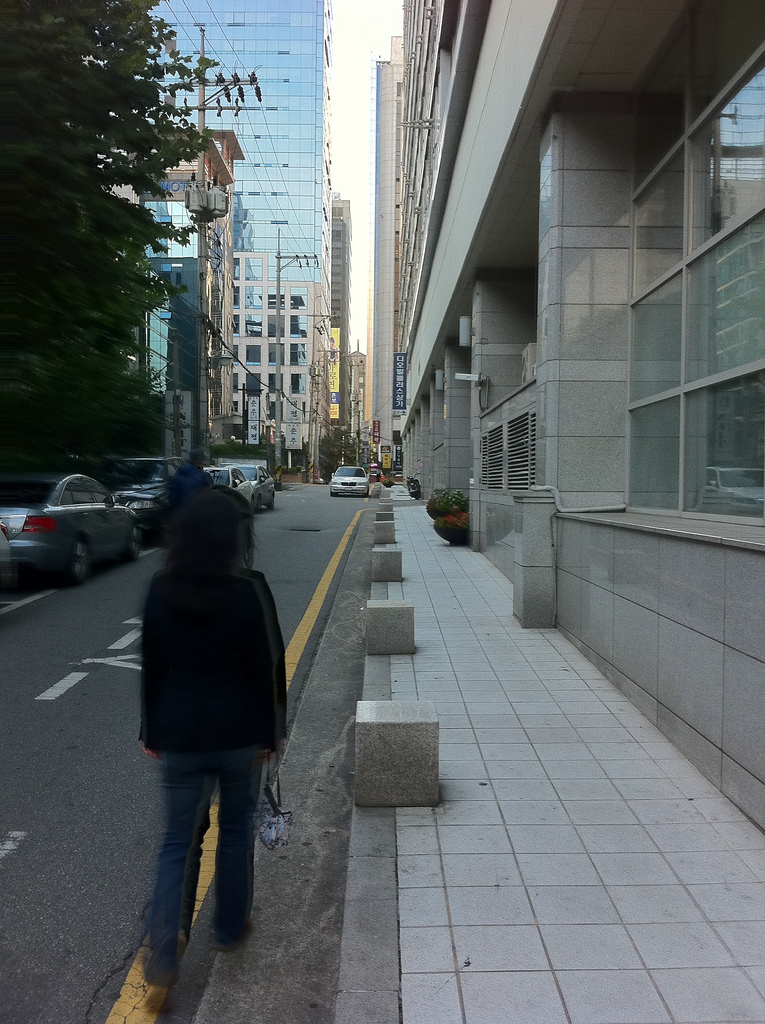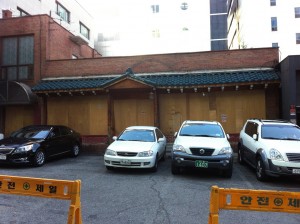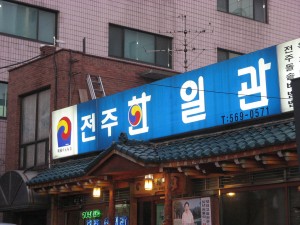I just recently watched Terence Malick’s Tree of Life so this post might have the remnants of the philosophical stupor I have been in for the last few days since watching it. Think me wistfully walking the streets of Seoul absorbed in thoughts of life, love, death, pensively gazing on the setting sun and doing my best impersonation of a Parisian avant-garde artist. Painful to watch, for sure. Either way, here I am and that wistfulness took me on a little journey yesterday.
My wife and I went to Gangnam in the southeastern part of Seoul (about 30-35 minutes by subway from our home in Mapo); Gangnam was our home from 2005-2006, that last, great year in Seoul before we headed back to the New World (ie, Princeton) and all the subsequent adventures there. It was a year of great activity, momentum, and closure. Knowing our time was limited (and never expecting to return), we were always walking, talking, eating, drinking, experiencing as much as we could of our new enclave.
One of our favorite restaurants turned out to be one of the most traditional, a yukhoe bibimbap (육회비빔밥) place tucked away off of Tehran-Ro (a very modern street off of the main Gangnam thoroughfare). It came complete with a picture of a grandmother out front (always a good sign) and the same grandmother within (even better sign). We ate there often and we always received big smiles when we came. One of the iconic places you think of when you think of your time in a particular place.
And on our return yesterday, we discovered it was boarded up and closed. It was gone, forever. No great tragedy in the grand scheme of events, but the sudden extinguished flicker of reality unlocking nostalgia can always be violent. In this case, it was a small tremor, a sigh, and a few seconds of staring at barred doors and not believing. It was reinforced by the sting of autumn that had just arrived (as in that day) in Seoul. It was our old neighborhood and it was surprisingly quiet; ever more quieter without this place. It was as if nobody had ever lived there but us. Ever. And our memories were all that would keep this location alive (yes, I am narcissistic this way). But then I thought, does it have to be this way? Does memory and that endowed legacy of memory and experience have to be such a fleeting, highly personal experience?
Why can’t we embed our memories into the objects and locations that mean something to us? So, someone can know, even for an instant, that yes indeed I was here and yes indeed this place was special for me. This is a bit of the hubris of humanity, that any of this does indeed matter, but it is cathartic for the individual. It is a bit of inverted closure because the place ceases to die, memory now runs concurrently with archived memory (embedded memory). And why not do this through augmented reality and geotagging?
Here is the restaurant now
and as we knew it before. This change is profound (although not monumental) and that significance is only found somewhere betweent these two photos of the same place. And only through reflection can we connect these points in time (but in the same space). Mobile learning can assist in this regard.
Use Case #1
If I had children (I don’t, but just imagine children as a metaphorical vehicle for wanting to impart a legacy on society), I could wander my streets, embed my photos, my reflections, sounds, my take on the ethos of the place itself. I could link people to these memories (relatives, friends, hyperlinked to some stream of their activity), I could literally embed my autobiography in the world itself. Chapters as locations, paragraphs of reflections, significance, and tons and tons of context. I could export this as an ebook (or just a file), I could essentially write a fairly detailed obituary for myself. Would anyone read/experience it? Besides the point. It is a healthy process of closure, with a place, or, if I am approaching death, with this world. Technology just assists in this regard.
Use Case #2
A child’s parents are divorced. The child must move with one parent or the other. The child can systematically record, reflect, and embed that which is important to them from their old home and neighborhood. Here is where I played football, here is where I first kissed a girl, here is where I got into a fight. A cathartic process of artistic expression towards coming to terms with traumatic changes and events. Kind of like an introverted therapy of reflection and expression.
Use Case #3
Understanding the renewed/altered/interactive nature of geography in a mobile world. There was this general sense with technology and the internet that geography matters less, that we are indeed all connected and that isolation is anachronistic. With mobile, we are rediscovering geography (place) as a core element of orientation in this world. That we are perpetually positioning ourselves in respect to beacons of aspiration (towards a university, towards family, towards my past and my future, towards a point of travel-think Paris as a beacon, the symbol of travel itself), towards beacons of what we are, what we are comfortable with, what we hope to be someday. Picking through the “old rag and bone shop of the heart”, wading through these memories in the context of where we experienced them, is an augmented reality unlike any other. It is a context of memory seething with the means to express, to exorcise, to heal, to reflect. So, I go to this old neighborhood in Seoul and I reflect on a younger version of myself and address the lingering hooks of my past (nostalgia) that can disrupt my future (hard to push forward when you are always looking backwards). Technology can be assistive in this way, by allowing us to reflect in situ, keep a record of that reflection, addend and augment in multimodal ways.
All of this from the confluence of the onset of fall, the closing of a favorite restaurant, expat life, mobile learning, and a Terence Malick movie.




